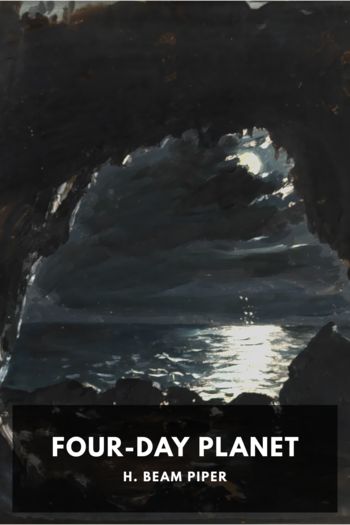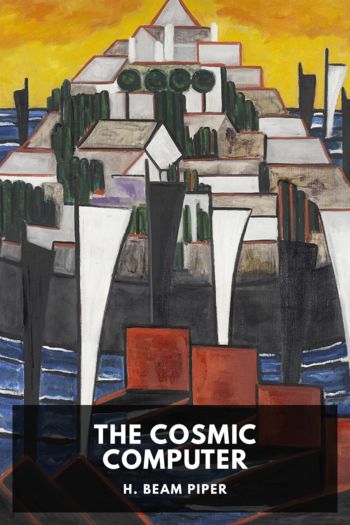Four-Day Planet, H. Beam Piper [best motivational novels .TXT] 📗

- Author: H. Beam Piper
Book online «Four-Day Planet, H. Beam Piper [best motivational novels .TXT] 📗». Author H. Beam Piper
The elevator door opened, and Lautier and the professor joined in the push to get into it. I hung back, deciding to wait for the next one so that I could get in first and get back to the rear, where my hamper wouldn’t be in people’s way. After a while, it came back empty and I got on, and when the crowd pushed off on the top level, I put my hamper back on contragravity and towed it out into the outdoor air, which by this time had gotten almost as cool as a bake-oven.
I looked up at the sky, where everybody else was looking. The Peenemünde wasn’t visible; it was still a few thousand miles off-planet. Big ragged clouds were still blowing in from the west, very high, and the sunset was even brighter and redder than when I had seen it last, ten hours before. It was now about 1630.
Now, before anybody starts asking just who’s crazy, let me point out that this is not on Terra, nor on Baldur nor Thor nor Odin nor Freya, nor any other rational planet. This is Fenris, and on Fenris the sunsets, like many other things, are somewhat peculiar.
Fenris is the second planet of a G4 star, six hundred and fifty light-years to the Galactic southwest of the Sol System. Everything else equal, it should have been pretty much Terra type; closer to a cooler primary and getting about the same amount of radiation. At least, that’s what the book says. I was born on Fenris, and have never been off it in the seventeen years since.
Everything else, however, is not equal. The Fenris year is a trifle shorter than the Terran year we use for Atomic Era dating, eight thousand and a few odd Galactic Standard hours. In that time, Fenris makes almost exactly four axial rotations. This means that on one side the sun is continuously in the sky for a thousand hours, pouring down unceasing heat, while the other side is in shadow. You sleep eight hours, and when you get up and go outside—in an insulated vehicle, or an extreme-environment suit—you find that the shadows have moved only an inch or so, and it’s that much hotter. Finally, the sun crawls down to the horizon and hangs there for a few days—periods of twenty-four G.S. hours—and then slides slowly out of sight. Then, for about a hundred hours, there is a beautiful unfading sunset, and it’s really pleasant outdoors. Then it gets darker and colder until, just before sunrise, it gets almost cold enough to freeze CO2. Then the sun comes up, and we begin all over again.
You are picking up the impression, I trust, that as planets go, Fenris is nobody’s bargain. It isn’t a real hell-planet, and spacemen haven’t made a swear word out of its name, as they have with the name of fluorine-atmosphere Nifflheim, but even the Reverend Hiram Zilker, the Orthodox-Monophysite preacher, admits that it’s one of those planets the Creator must have gotten a trifle absentminded with.
The chartered company that colonized it, back at the end of the Fourth Century a.e., went bankrupt in ten years, and it wouldn’t have taken that long if communication between Terra and Fenris hadn’t been a matter of six months each way. When the smash finally came, two hundred and fifty thousand colonists were left stranded. They lost everything they’d put into the company, which, for most of them, was all they had. Not a few lost their lives before the Federation Space Navy could get ships here to evacuate them.
But about a thousand, who were too poor to make a fresh start elsewhere and too tough for Fenris to kill, refused evacuation, took over all the equipment and installations the Fenris Company had abandoned, and tried to make a living out of the planet. At least, they stayed alive. There are now twenty-odd thousand of us, and while we are still very poor, we are very tough, and we brag about it.
There were about two thousand people—ten percent of the planetary population—on the wide concrete promenade around the spaceport landing pit. I came out among them and set down the hamper with my telecast cameras and recorders, wishing, as usual, that I could find some ten or twelve-year-old kid weak-minded enough to want to be a reporter when he grew up, so that I could have an apprentice to help me with my junk.
As the star—and only—reporter of the greatest—and only—paper on the planet, I was always on hand when either of the two ships on the Terra-Odin milk run, the Peenemünde and the Cape Canaveral, landed. Of course, we always talk to them by screen as soon as they come out of hyperspace and into radio range, and get the passenger list, and a speed-recording of any news they are carrying, from the latest native uprising on Thor to the latest political scandal on Venus. Sometimes the natives of Thor won’t be fighting anybody at all, or the Federation Member Republic of Venus will have some nonscandalous politics, and either will be the man-bites-dog story to end man-bites-dog stories. All the news is at least six months old, some more than a year. A spaceship can log a light-year in sixty-odd hours, but radio waves still crawl along at the same old 186,000 mps.
I still have to meet the ships. There’s always something that has to be picked up personally, usually an interview with some V.I.P. traveling through. This time, though, the big story coming in on the Peenemünde was a local item. Paradox? Dad says there is no such thing. He says a paradox is either a





Comments (0)